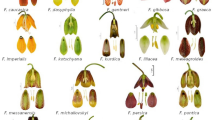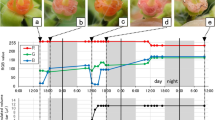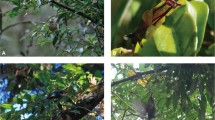Abstract
MANY angiosperms depend on insects or birds to accomplish pollination or seed dispersal, and the appropriate parts of the plants are brightly coloured, usually with carotenoid or flavonoid pigments. It is generally agreed that these pigments serve a useful purpose in attracting animal visitors, and therefore their presence has selective value; but while this may explain their production and maintenance in some angiosperms, it does not account for their original establishment in the plant kingdom. For carotenoids similar to those commonly found in flowers and fruits occur in all lower groups of plants, and anthocyanins (flavonoids) are found both in mosses1 and in ferns2. Hence there is reason for believing that both types of pigment were produced in plants long before angiosperms had evolved, and have some function or functions unconnected with attracting the attention of animals.
This is a preview of subscription content, access via your institution
Access options
Subscribe to this journal
Receive 51 print issues and online access
$199.00 per year
only $3.90 per issue
Buy this article
- Purchase on Springer Link
- Instant access to full article PDF
Prices may be subject to local taxes which are calculated during checkout
Similar content being viewed by others
References
Herzfelder, H., Beih. Bot. Zbl., 38 (1), 355 (1921).
Price, J. R., Sturgess, V. C., Robinson, R., and Robinson, G. M., Nature, 142, 356 (1938).
Emerson, R., and Fox, D. L., Proc. Roy. Soc., B, 128, 275 (1940).
Heilbron, I. M., Nature, 149, 398 (1942).
Murneek, A. E., Science, 79, 528 (1934).
Moewus, F., Ergebn. Enzymforsch., 12, 173 (1951).
Ryan, F. J., Science, 122, 470 (1955).
Gascoigne, R. M., Ritchie, E., and White, D. E., J. Roy. Soc. N.S.W., 82, 44 (1948).
Bate-Smith, E. C., Biochem. Soc. Symp., 3, 62 (1950).
Bate-Smith, E. C., Biochem. J., 58, 122 (1954).
Author information
Authors and Affiliations
Rights and permissions
About this article
Cite this article
HARTSHORNE, J. Pigmentation and Sexuality in Plants. Nature 182, 1382–1383 (1958). https://doi.org/10.1038/1821382a0
Issue Date:
DOI: https://doi.org/10.1038/1821382a0
This article is cited by
-
Intraspecific flavonoid variation
The Botanical Review (1987)
-
Five plants of the family Cucurbitaceae with flavonoid patterns of pollens different from those of corresponding stigmas
Experientia (1980)
-
Flavonoids from pollens and stigmas of male and female flowers of four species of the genusCucurbita
Experientia (1979)
Comments
By submitting a comment you agree to abide by our Terms and Community Guidelines. If you find something abusive or that does not comply with our terms or guidelines please flag it as inappropriate.



